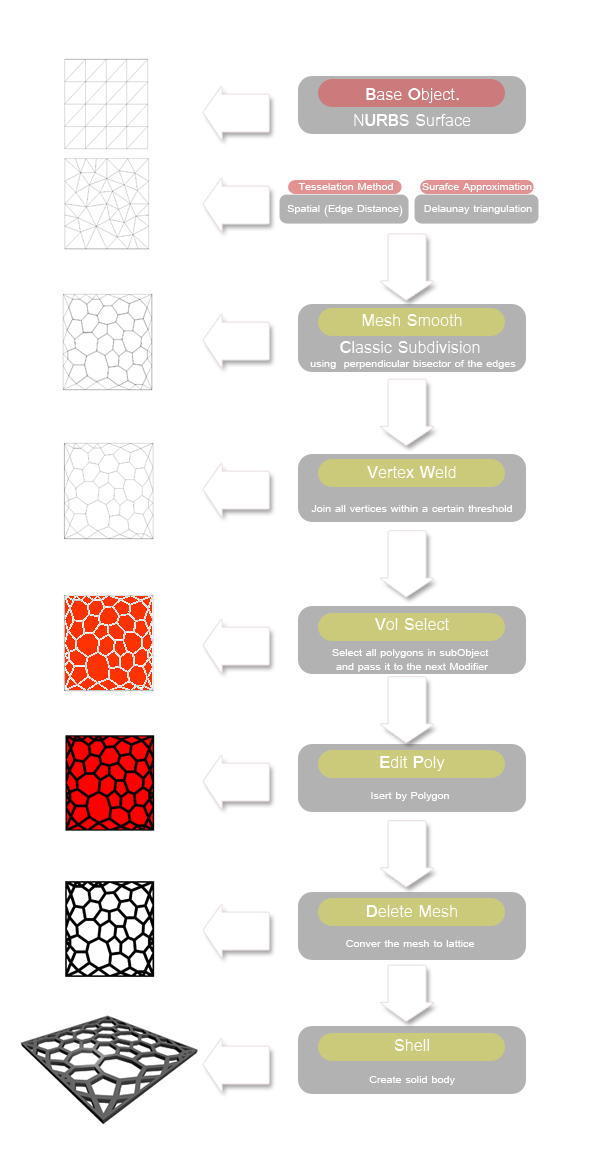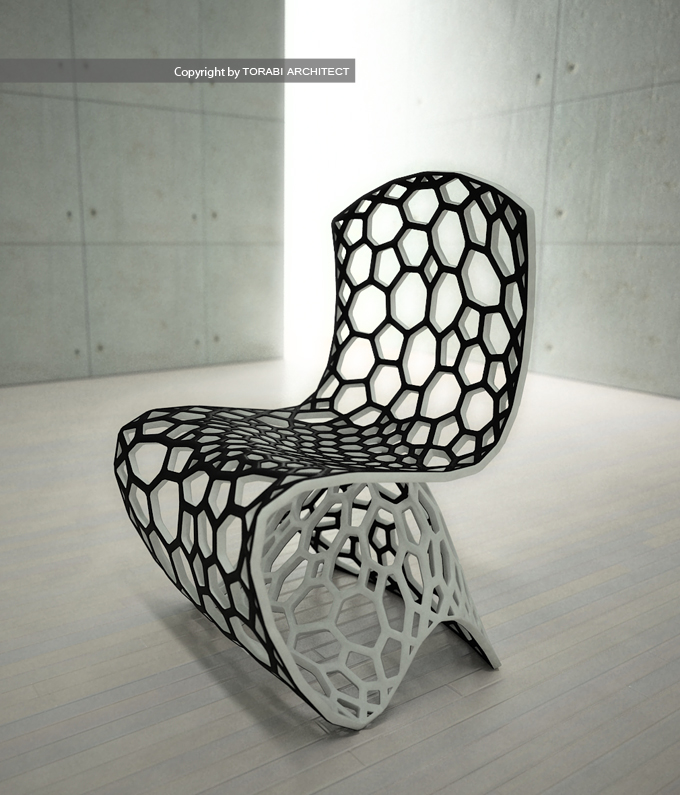Voronoi Tessellation
let me introduce my Voronoi Chair (I) !,
You may think that I have used some special program or script. But this is simply result of combining a few modifiers on top of a NURBS geometry in 3ds MAX.
Here is the Voronoi tessellation diagram using 3ds max modifiers. this approach is fully parametric and you can control the final result in any aspect. Just go through the stack and make your setting.

Note: To keep the interactivity with geometry you need to use EditPoly modifier in animate mode!
June 26, 2010 at 12:45 pm

October 11, 2011 at 11:25 pmadmin
link | my site | author
use subdivide modifier , then follow steps from mesh smooth modifier
October 10, 2011 at 3:03 amMatt
link
I am brand new to 3ds Max, and uncomfortable with NURB modeling. How can i get a delaunay triangulation without NURBS modeling? Unlike Mr.Teeter, I am getting unsatisfactory results subdividing and tessellating my geometry (3ds Max Standard Primitives). I am Interested in using the voronoi tessellation as a structural geometry in my architecture studio course.
August 17, 2011 at 2:21 pmadmin
link | my site | author
if you are working with NURBS then you must try a different parameterization of NURBS surface , play with options under surface approximation. I prefer the SPATIAL only. edge value controls the size of cells.
August 17, 2011 at 7:14 amcr3
link
when i put on the tesselation around the edges i get lots of extra segments not the clean version as you have shown, any ideas?
May 11, 2011 at 2:30 pmDams
link
Hi, thanks for your answer. I got the process but i’m still a beginner in MAX and i get stuck somewhere… I don’t know if it’s after “vertex weld” or at “vol select” but compare to your schema, i don’t have the vertices in white and faces in red (in the 5th one). All is red and vertices are not thick.
if someday you make a video of this tutorial maybe i’ll get it 😉
Thanks again!!!
May 8, 2011 at 9:38 amadmin
link | my site | author
Hi, did you get your answer?
May 6, 2011 at 10:04 amadmin
link | my site | author
Hi Dams,
The vol sel modifier allow you to select all faces inside the mesh with no need of going back and pick them all as what you do in poly select,
It means if you change the base object and it generates more number of faces these extra faces will be selected by vol select automatically but if you put the poly select instead the additional faces won’t be in your selection, so that’s the reason we are using vol select to keep the flow of information all through the modifier stack. In next modifier (editpoly) when you enter the polygon mode set the animate option and insert the polygon.make sure you insert them when the polygon option is active (group option doesnt open the faces) sinse you got all the faces by the previous modifier choose “use stack selection”
I hope this resolve your issue don’t hesitate to post again if you need more information
May 4, 2011 at 2:36 amDams
link
oups!!!
send too quick
so
i’m stuck in “vol select”
what do you mean by “select all polygons in subobject”, i can only select vertex or faces and then if i go further i get nothing like you do…
i would appreciate if you can help me!!!
thanks in advance, really good job
May 4, 2011 at 2:33 amDams
link
Hello,
great approach to voronoi, but i’m stuck to “vol select” part…
what do you me
December 18, 2010 at 12:28 pmadmin
link | my site | author
use classic method for subdivision method and set the strength value to 1.(maximum)
December 11, 2010 at 7:54 pmradu
link
hello! just wondering if you can explain to me how the mesh smooth works cause I’m stuck at that step. I don’t know how to set it to use the perpendicular bisector of the edges. tnx!
August 31, 2010 at 10:36 amAli
link | my site
Hey Chris,
yes! you are absolutely right, the proof is that “Subdivision” modifier also use Delaunay triangulation method to subdivide a surface. Thanks for your feedback.
August 27, 2010 at 7:22 pmChris Teeter
link | my site
Hey Ali, I was trying to figure out other ways to get the Delauney triangulation besides via NURBS and just by chance applied the “Subdivision” modifier to an object on another job and did all the other steps above and it looks right. I’m pretty sure that works for getting a Voronoi subdivision on any object, but just wanted a second opinion.
thanks
July 30, 2010 at 10:09 amadmin
link | my site | author
Salam , man ta 10 August Iran hastam, lotfan ba shomare hamrahe man tamas begirid,
09121879139 , khosh-hal misham.
July 30, 2010 at 9:30 amali
link | my site
salam. vagean karhaye jalebi anjam dadin. baese eftekhare. ye soal dashtam, inke chetori mitunam MathSurf estefade konam. man download kardam, nasbam kardam vase max 2009. lotfan rahnemayim konid.
ba arezuye behtarin ha, movaffag bashid.
July 25, 2010 at 8:41 amChris Teeter
link | my site
excellent! the art of subdivision structures…doing the last bit in different ways.
was playing around with parametric array, but lost it on my other laptop that crashed.
keep up the good work.